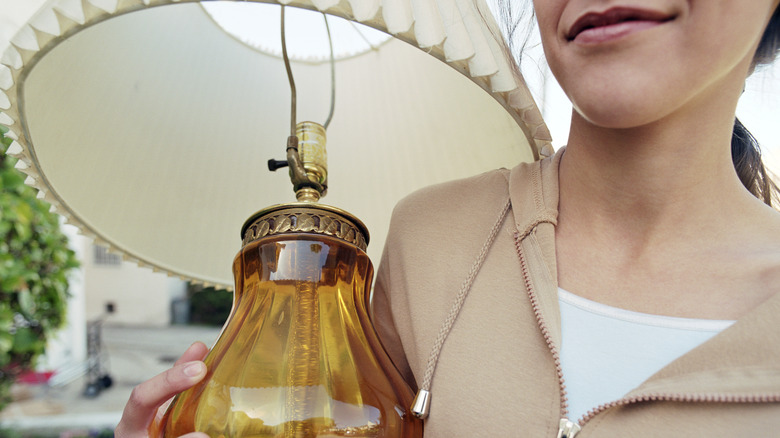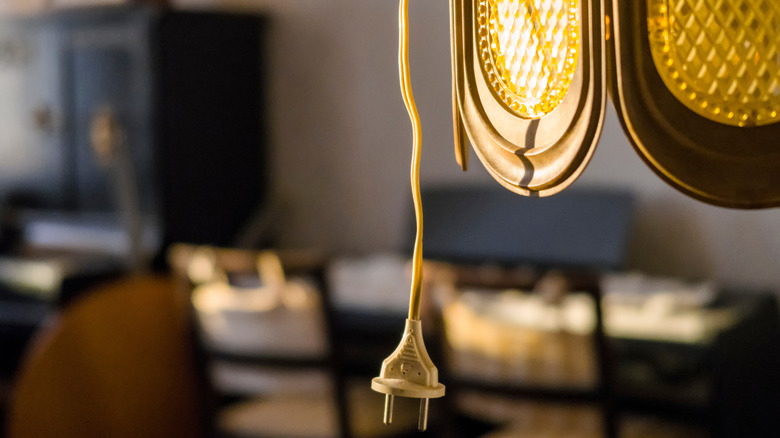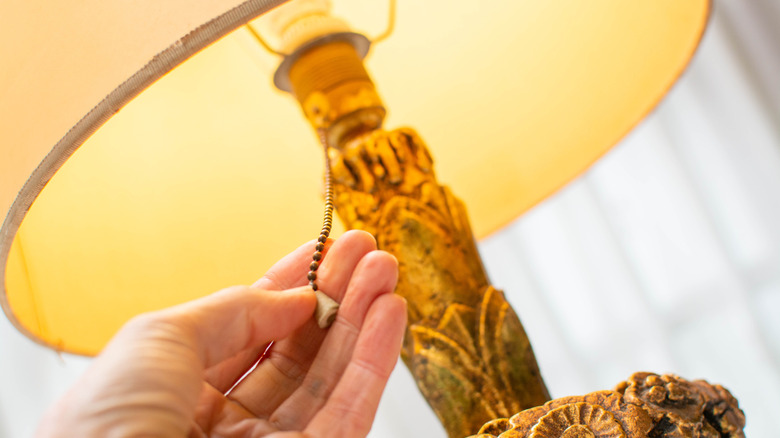How To Tell If A Vintage Lamp Is Safe
Finding a quality vintage lamp can be the highlight of a thrifting quest or an estate sale weekend. Whether you discover a piece with art deco design or a well-crafted copper floor lamp, you may have stumbled upon a way to give your home extra personality. But it's best to temper your excitement until you know whether that regal-looking statement piece can actually be used once you bring it home, and won't pose the risk of dangers like electrical fires. To tell if a vintage lamp is safe, you'll want to carefully look over its socket, plug, and electrical cord, and as an extra security measure, you can consider getting the lamp a new Underwriters Laboratory (UL) certification. Keep up the vigilance by also making sure you're using the appropriate bulb for the lamp once you take it home.
There are some cases when you don't have to pay as much attention to the electrical requirements of an older lamp, depending on your plans for it. If you want to take out the lamp's old wiring because you'll replace it with something else (solar equipment if you're trying a thrifted vintage lamp DIY to light up your outdoor space, for example), focus more on what you'll install than whether the existing components are up to snuff. If you'll be using the lamp for décor but intend to keep it unplugged, accidents happen and it's possible someone in the home could plug it in without thinking, so it's still safest to know whether or not that would be risky.
Vintage lamp components you should inspect
Start by inspecting the most-used parts of your desired lighting fixture. This will help you answer the one question to ask before buying a vintage lamp — whether it needs to be rewired. The work may already have been done for you; you may even notice a brand new socket or cord contrasting with its antique style. The cord should be flexible, and ones that feel brittle, appear frayed, or are covered in cloth all mean that you should either skip buying the lamp or be aware that it needs rewiring. A fix may also be needed if that cord is loose. When you get to the plug, it's likely safe if it's polarized, meaning there are either three prongs or two differently-sized prongs. If the plug has two prongs equal in size, though, it's dangerous to plug into most wall outlets in a modern home. Don't forget to examine the socket — the lamp shouldn't be used if this piece is discolored or corroded. When you've identified a lamp that will need repairs, it's time to weigh the effort and costs involved with updating it to assess whether you've really found a bargain. A rewiring project — which many vintage lamps require — could involve finding a professional, or learning the skill that makes thrifted lamps work like new again yourself.
In addition to its other components, the lamp may have a "UL Certified" label, which indicates it met the standards of a global company that certifies safety of appliances, but odds are that it may need to be re-certified if you want to be sure that it meets today's requirements. Once you buy the lamp, you can work with a business or technician who performs UL testing and certification for that extra security.
Pay attention to bulb wattage in vintage lamps
Even after you've determined a vintage lamp is safe to use, it may take some more investigation to make sure you're using a lightbulb that won't cause any home safety problems. Using a bulb that draws more power than the lamp is designed for puts you at risk for fires and damage to your new vintage find. Check the socket of the lamp for a wattage rating, which will look like a label or engraving that tells you the maximum wattage the lamp can handle. For lamps that hold multiple bulbs, the number may show you the total wattage it can accommodate, so you'll have to add up the wattages of each individual bulb you choose.
In the absence of this kind of direction, it's often advised to start with 60-watt bulbs (or its equivalent in an LED bulb, which is measured in lumens), since many lamps are wired to draw at least that much power. An LED bulb is more energy efficient and will last longer, plus there are online conversion charts that can help you figure out what LED bulbs are compatible with classic fixtures. You'll know a lightbulb has too high a wattage for the vintage wiring (or other undiagnosed issues) if you detect a burnt smell or see scorch marks. In this case, you'll want to unplug it immediately, and — especially if the bulb wattage is within the guidelines — consult with an electrician before plugging it in again.


